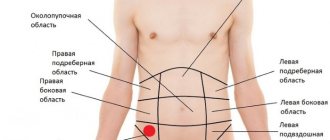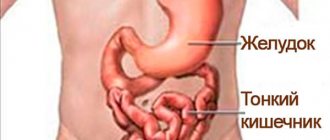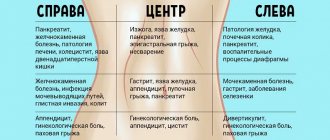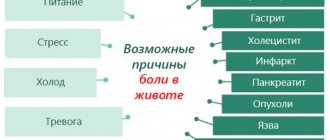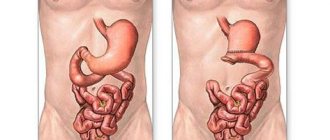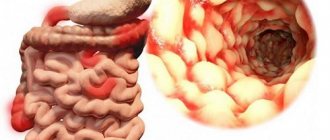The iliac region is part of the anterior lateral region. It is located between the lower ribs and the pelvic bones and is shaped like a depression.
The right iliac fossa contains the cecum, covered with peritoneum, the appendix and the ileum. In a state of moderate filling, the cecum is closed in front by loops of the small intestine. If it is inflated with gases, it occupies the entire iliac fossa.
In the left region there are loops of the jejunum. The sigmoid colon runs from the iliac crest to the third sacral vertebra. If the bladder and rectum are full, the loops of the S-shaped colon move into the ileal fossa.
The iliac region also contains a vein, ureter, ovarian vessels, round ligament of the uterus (in women), vas deferens (in men), and branches of the lumbar nerve plexus.
What diseases are localized within this area
Pain in the iliac fossa signals a disease. The pain can be constant or periodic, sharp and aching. They can appear during heavy physical exertion, prolonged absence of stool, overeating and for no apparent reason.
Painful attacks in the iliac region most often signal diseases of the gastrointestinal tract. But next to them are the genital and urinary organs, so the cause of the pain may be different.
If you have a stomach ache on the right or left side, you need to see a therapist. If necessary, he will recommend visiting specialized specialists: proctologist, gynecologist, surgeon, gastroenterologist.
After studying the external signs and symptoms, the doctor will make an accurate diagnosis. In some cases, colonoscopy or sigmoidoscopy of the intestines, ultrasound of the kidneys, gallbladder, pancreas and pelvic organs, and fibrogastroscopy may be required.
Remember that pain in the lower abdomen may indicate a serious health problem and the need to seek urgent emergency care.
If pain is severe, you should not take analgesics. Many of them effectively reduce sensitivity, thereby making diagnosis more difficult.
The most common diseases that cause pain in the iliac region:
inflammation of the appendix. inflammation of the iliac lymph nodes and retroperitoneal tissue. sigmoid colon volvulus. gynecological diseases. inflammation of the seminal vesicles. complications after prostatitis. abscesses of the iliopsoas muscle. osteochondrosis. urological disorders. intestinal dysbiosis. helminthic lesions. inflammatory processes in the gastrointestinal tract. femoral and inguinal hernia.
Classification of diseases
Diseases that cause pain in the left iliac region are:
- Gynecological. Discomfort can accompany tubal pregnancy and adhesive disease. In addition, the causes of pain are any ovarian pathologies, for example, endometriosis, neoplasms, apoplexy.
- Intestinal. Such diseases include non-ulcer sigmoiditis, colitis, appendicitis, Crohn's disease, and intestinal infections.
- Splenic. In such situations, pain accompanies an abscess, neoplasms, and volvulus of the spleen.
- Urological. Painful sensations are caused by urolithiasis, nephritis, pyelitis, cystitis, pyelonephritis.
All types of pain are divided into two groups indicated in the table.
Group
Description
Organic pain
Impaired blood supply Inflammatory processes Dystrophic changes
Ovulatory syndrome Bent uterus Cycle failure Blood stagnation Bloating
Soreness in most situations signals the development of some pathology.
What does pain in the left side of the iliac region mean?
Painful sensations can signal diseases associated with the gastrointestinal tract. When the wall of the large intestine becomes inflamed (colitis), aching pain appears with bloating, false urge to defecate, and diarrhea with mucous admixture. These symptoms last from several days to several weeks. If you do not consult a doctor, the disease becomes chronic and occurs with periodic exacerbations.
Colic in the left side, worsening after eating and accompanied by frequent bowel movements, bleeding from the anus, can be caused by ulcerative colitis. To diagnose the disease, histological and endoscopic examination will be required.
Lesions of the sigmoid colon (tumors, bleeding ulcers) are accompanied by a painful urge to defecate and frequent loose stools. The stool contains impurities of blood and pus. With congenital elongation of the sigmoid colon (dolichosigma), the same symptoms are observed. The diagnosis of sigmoid colon cancer is based on data from sigmoidoscopy, fibrocolonoscopy and biopsy.
Pain caused by intestinal narrowing and ulcers, and nighttime diarrhea may indicate Crohn's disease. With complete narrowing of the intestine, spastic pain, vomiting, and lack of stool occur. Crohn's disease is determined after irrigoscopy, endoscopic examination with biopsy. With intestinal obstruction in the left part of the iliac region, cramping pain occurs at any time, regardless of food intake. It is often accompanied by nausea, vomiting, bloating, and stool retention.
More severe symptoms (lack of stool, sharp pain, difficulty breathing) indicate volvulus of the sigmoid colon or small intestine. To confirm the diagnosis, X-ray and ultrasound examination of the abdominal organs is performed. If these symptoms occur, seek medical attention immediately. There is a high probability of intestinal rupture and the development of peritonitis.
Pain in the left lower abdomen with intestinal cancer is usually poorly expressed. Tumors interfere with the movement of feces, so the disease is accompanied by persistent constipation and bloating. After the passage of stool and gases, the pain temporarily stops. Data on the condition of the intestinal mucosa obtained during colonoscopy help confirm or exclude the disease and clarify the location of the tumor.
Parasites that live in the small intestine can cause pain in the lower left side of the abdomen. Helminthiasis contributes to the development of intestinal obstruction. Pain in the left part of the iliac region occurs with: hepatitis, stomach ulcers, chronic gynecological pathologies, dilated veins in the pelvis, ectopic pregnancy. They are usually accompanied by other symptoms.
Only a specialist can identify the pathology and prescribe treatment.
Anatomical features of the iliac zone
Part of the ventral-lateral section lies between the lowermost ribs and the pelvic bones.
In the iliac recess on the right there are:
- cecum, covered with abdominal tissue;
- appendix;
- ileal intestinal segment.
With average filling, the cecum is closed in front by a loop-shaped small intestine. If it swells due to a large amount of gas, it fills the entire ileal bowl.
The jejunum is located in the left abdominal zone. The S-shape starts from the iliac crest and extends to the third vertebra. When the bladder and rectum fill, the sigmoid moves into the cavity.
This place also contains a vein, urinary ducts, ovarian vascular system, uterine round ligament, spermatic canal, and branches of the lumbar nerves.
Pathologies of all these organs can cause pain in a nearby area with a variety of additional symptoms.
Cramping syndrome usually indicates muscle spasms, colic, or intestinal obstruction. Pain that increases gradually indicates the presence of internal inflammation.
What does pain in the right iliac region indicate?
The cecum is located in the lower right part of the abdomen. A vermiform appendage extends from it. Fecal stones and undigested food clog the entrance to the rectum. Due to the blockage, the appendix swells and stretches. Pathogenic bacteria are involved in this process. Painful sensations during inflammation of the appendix vary in nature and are almost not bothersome at the initial stage. But over time, they intensify and are localized in the right iliac region. Throbbing pain is accompanied by nausea and fever. If the patient does not receive medical care in time, the appendix may rupture with the development of peritonitis.
Please note that inflammation of the appendix is sometimes fatal!
Usually, additional examinations are not necessary to determine appendicitis. But it can be confused with intestinal obstruction, inflammation of the lymph nodes of the intestinal mesentery (mesadenitis), pyelonephritis, ectopic pregnancy, rupture of an ovarian cyst. In some cases, laparoscopy or computed tomography is required to diagnose appendicitis. Pain in the right lower abdomen is characteristic of inflammation of the ileum (enteritis). It is accompanied by diarrhea, nausea, and the release of undigested food debris. To distinguish enteritis from other diseases, the patient is prescribed an endoscopic and x-ray examination, ultrasound of the pancreas.
Pain in the right side of the iliac region in the presence of stones in the gall bladder, perforated ulcer, pyelonephritis of the right kidney.
Damage to the appendages, uterus and bladder, and genital infections also cause pain in the right lower abdomen. Constant pain in some cases signals the presence of an ovarian tumor. Painful impulses coming from the lower abdomen warn of problems with the seminal vesicles in men or prostatic hyperplasia.
Each of these diseases is serious and can significantly reduce quality of life, and some can lead to death.
What diseases can there be if it hurts in the left or right iliac region?
The iliac region is the collection of anterolateral sections of the peritoneum located from the lower ribs to the pelvic bones and the suprapubic area. From the point of view of doctors, it is more correct to call this area of the peritoneum the ilioinguinal, since it includes the zones of the groin areas with the underlying part of the peritoneum - the iliac fossa. The area where the right iliac region is located includes sections of the ileum and cecum, the appendix, and the ascending colon begins here. When the digestive tract is minimally full, the area of the cecum is partially covered by the small intestine. If gases accumulate in excess in the lumen of the cecum, practically the entire space of the iliac fossa is allocated to it.
In the area where the left iliac region is located, there are intestinal loops, including the jejunum and sigmoid colon with the mesentery, and here the colon ends in its descending part. The sigmoid colon, curved in a loop, extends from the iliac crest to the third sacral vertebra. When the bladder cavity is filled, the same applies to the rectum, the S-shaped sigmoid zone moves into the space occupied by the iliac fossa.
The iliac region also includes the vena cava section, ureters, nerve plexus, vascular branches from the appendages (ovaries with fallopian tubes), rounded uterine ligament (women), vas deferens (men).
Do you still think that healing your stomach and intestines is difficult?
Judging by the fact that you are now reading these lines, victory in the fight against diseases of the gastrointestinal tract is not yet on your side...
Have you already thought about surgery? This is understandable, because the stomach is a very important organ, and its proper functioning is the key to health and well-being. Frequent abdominal pain, heartburn, bloating, belching, nausea, bowel dysfunction... All these symptoms are familiar to you firsthand.
But perhaps it would be more correct to treat not the effect, but the cause? Here is the story of Galina Savina, about how she got rid of all these unpleasant symptoms... Read the article >>>
It is important to know! The only remedy for gastritis and stomach ulcers recommended by doctors! ...
Pain in the left iliac region can be caused by various reasons. In this text material, we will find out how this kind of pain manifests itself, what are the reasons that cause it, and what to do if such a symptom occurs?
And a little about secrets...
Are you tired of stomach pain, nausea and vomiting...
And this constant heartburn... Not to mention bowel disorders, alternating with constipation... It’s sickening to remember the good mood from all this...
Therefore, if you are suffering from an ULCER or GASTRITIS, we recommend that you read Galina Savina’s blog about how she coped with gastrointestinal problems. Read article »
Pain in the so-called iliac region is not a typical symptom that clearly indicates the presence of a specific disease. This is a special “alarm signal”, the main task of which is to make a person think about his health, and, if necessary, consult a doctor to find out the causes of such pain. Why can they arise and how to deal with them?
Why pain appears in the iliac region: common causes
Pain in the lower left and right parts of the abdomen is not an independent pathology or disease, but indicates the presence of certain pathologies in the body, diseases of certain organs or their systems. They can be short-term or long-term, intense or mild, permanent or temporary, occur at different times of the day and are accompanied by other accompanying symptoms.
To understand how to get rid of such pain, you need to find out what provokes it. The main “culprits” for the appearance of pain in the left or right iliac region are:
Varicose veins
. Pathology can occur not only in the upper or lower extremities, but also in the abdominal area. Problems with veins in the pelvic organs are a fairly common phenomenon among patients, which most often affects women whose work involves long periods of standing.
Diseases of the urinary system
. Urolithiasis, prolapse of the ureter, cystitis often manifest themselves as pain in the iliac region. Most often, such pain is acute, reminiscent of renal colic, and in some cases is evidence of blockage of the ureter with a stone or problems with the outflow of urine from the kidneys.
Inguinal or femoral hernia
. Pathologies in which pain can occur in both the left and right lower abdomen (depending on the location of the problem area).
Osteochondrosis
. Causes pain in the direction of the affected nerve and can also be accompanied by pain radiating to the iliac zone.
Lengthening the sigmoid colon
. It can lead to the formation of an additional loop of intestine in the abdominal cavity and, under certain circumstances, cause unpleasant pain in this area.
Irritable bowel syndrome
. A very common pathology among many patients, as a result of which the intestines are in a spastic state for a long time. In addition to pain, a person may experience increased anxiety, irritability, and disturbances in intestinal motor function.
Inflammation of the large intestine
. Most often we are talking about a disease such as colitis. The latter manifests itself not only with pain in the ileal region, but also with other unpleasant symptoms characteristic of diseases of the gastrointestinal tract: constipation, bloating, mucus in the stool, etc.
Other causes of pain:
prolapse of the intestines or kidneys; dysbacteriosis; appendicitis; inflammation of the genital appendages or organs responsible for excreting urine; gastrointestinal tumors; gynecological diseases in female patients; urological diseases in men.
The most common causes of pain
There are ailments due to which pain in the iliac region manifests itself most often. Moreover, this does not depend on the gender and age of the patient.
Irritable bowel syndrome. A frequently recorded pathological deviation, due to which the intestinal muscles remain in a convulsive state for a long period. The patient experiences torment from strong contractions on both sides and in the center of the abdomen, becomes irritable, and experiences anxiety. The motor functioning of the intestine is impaired.
Obstruction of the intestinal tract. Painful manifestations of a cramping type in the left part of the iliac zone occur regardless of food intake. It is often accompanied by heaviness, belching, nausea, vomiting, bloating of the abdominal cavity, and the person suffers from constipation.
Infection with helminths. Clusters of helminths provoke obstruction. The activity of worms in the small intestine can cause dull pain on the left side of the lower abdomen.
Lengthening of the sigmoid colon. It can lead to the formation of an additional intestinal loop and provoke painful manifestations of the cutting type. Additional symptoms include lack of bowel movements and difficulty breathing.
Colitis. If the wall tissues of the large intestine become inflamed, the stomach aches, bloating occurs, diarrhea with mucus occurs, and you always want to go to the toilet. These symptoms last from several days to a month or more. If this is a nonspecific ulcerative type of the disease, colic in the left side intensifies after eating and is accompanied by frequent bowel movements and hemorrhages from the anus.
Enteritis. A person experiences pain in the lower peritoneum on the right. Diarrhea and nausea begin, and undigested food remains come out.
Appendicitis. Pain syndromes during inflammation of the appendix are of various types and in the first phase are practically not disturbing. Gradually they increase and become local with a concentration in the right abdominal region, unbearable when pressed. Pulsating attacks are accompanied by nausea and a rise in temperature.
Bowel cancer. Painful manifestations in the lower abdomen with such a disease are usually quite mild. Neoplasms obstruct the movement of excrement, which leads to persistent defecation delays and swelling of the peritoneal region. After the release of excrement plugs and gases, the pain subsides for a while.
Urolithiasis and urinary duct prolapse. They report themselves by painful manifestations in this area. Often acute pain, similar to renal colic, indicates blockage of the urinary canals with a stone or dysfunction of urinary diversion.
Cystitis. In addition to pain, the patient suffers from constant unsuccessful attempts to release the bladder, burning and stinging, if this is still possible. If the unpleasant feelings increased in intensity and spread to the posterior hypochondrium, the inflammation probably spread to the kidneys and caused pyelonephritis.
Cholecystitis and cholelithiasis. When exacerbating, they provoke the appearance of burning pain on the right side, especially when inhaling, when straightening the body, and walking.
Varicose veins The development of pathology is possible in the abdominal area. Incompetence of the venous vessels in the pelvic area often occurs in those who have to stand for long periods of time at work. The disease is characterized by aching pain in the legs and abdominal area, especially at night.
Inguinal or femoral hernia. Aching pain manifestations can appear in the left and right zones of the peritoneum from below - depending on the location of the problem area.
Osteochondrosis. It provokes aching pain in the direction of the affected nerve fiber, which radiates to the iliac region and to the hip joint.
Sometimes painful sensations are provoked not by pathological abnormalities and ailments, but by excessive physical exertion and mental fatigue. In the first variant, the muscle structures become tense, a burning sensation and tingling sensation appear. During nervous stress, pain occurs on the sides of the peritoneum and in the middle.
Pain in women
Very often, women face the problem of pain in the right or left iliac region. Most often it occurs against the background of diseases of the female genital area. The main causes of such pain syndrome in the fairer sex are as follows:
Menstrual irregularities due to hormonal imbalances
. Pain can occur at any time of the cycle (both at the beginning and middle, and at the end), and is often accompanied by dysfunctional uterine bleeding. With such disorders, women complain of acute, paroxysmal or aching pain in the iliac region and in the lower abdomen.
Infectious diseases
. Ailments such as adnexitis, endometritis, vaginitis, salpingoophoritis also make themselves felt by pain in the corresponding localization. With inflammation of the ovaries or appendages, pain is observed in the left or right iliac region, depending on which ovary and fallopian tube the inflammatory process occurs in. Simultaneous inflammation of the left and right ovaries and fallopian tubes causes pain on both sides at once.
In acute inflammation, the pain is very severe, accompanied by chills, fever, migraine, and atypical discharge from the external genitalia. Chronic inflammation in the organs of the female reproductive system occurs against the background of aching, bursting or mild pain in the iliac region.
Ectopic pregnancy
. It manifests itself as pain in the right or left iliac region and, as a rule, occurs at 4-6 weeks of pregnancy. At first, the pain syndrome is weak, almost unnoticeable. As the fertilized egg grows, the pain intensifies. In later periods, severe internal and external bleeding may occur.
Ovarian cyst
. Depending on the location of the tumor, pain may be in the left or right side of the abdomen. A woman, as a rule, is disturbed by a moderately severe pain syndrome, aching, squeezing pain.
If, in the presence of an ovarian cyst, sharp, unbearable pain appears, this may indicate such a serious condition as torsion of its legs, requiring emergency surgical care.
Ovulation
. In some women, the process of release of the egg from the follicle is accompanied by intense pain in the lower abdomen and iliac region. Recognizing such pain is quite simple - it always occurs at the same time (on the 14th-16th day of the menstrual cycle) and goes away quite quickly without any treatment.
Tumors of the uterus and ovaries
. Not very common “culprits” of pain in the iliac region, which are most often diagnosed in women who have crossed the age mark of 50 years.
Pain in pregnant women
Any pain in the abdomen during gestation in the iliac region can indicate both physiological changes and some trouble in the body.
Most often, such pain can be caused by the rapidly increasing size of the uterus, in which the fetus develops. As a rule, such pain is mild, appears suddenly and passes rather quickly, without causing much discomfort to the pregnant woman.
Sometimes the pain syndrome is caused by digestive disorders, which are very common among pregnant women. Women who suffer from constipation during pregnancy regularly feel pain in the left iliac region. To get rid of such pain, it is enough to adjust your diet and normalize your daily routine.
Excessive activity of the baby in late pregnancy also leads to pain in the lower abdomen. An already grown and strengthened baby can rest against the abdominal organs, which results in the appearance of pain.
Women “in an interesting position” should remember that any pain in the left or right iliac region during pregnancy requires consultation with a doctor.
What causes pain in men?
In men, various pain sensations in the iliac region are rarer than in women, but still occur. In 95% of cases, pain with this location appears in representatives of the stronger sex with the following diseases:
With vesiculitis
. A disease in which the source of inflammation is located in the seminal vesicles. Pain can disturb not only in the left and right iliac region, but also in nearby parts of the spine - radiating to the lumbosacral area and lower extremities.
For prostatitis
. Both infectious and non-infectious prostatitis can cause indirect painful sensations in the lower part of the peritoneum. This pathology is accompanied not only by pain, but also by other unpleasant symptoms: problems with urination, erectile dysfunction, increased irritability, etc.
Inflammation of the kidneys, bladder, urinary tract
. Cystitis is a common pathology among men, which is accompanied by pain in the iliac region. The patient suffers from frequent and painful attempts to empty the bladder.
Has the pain become intense and pronounced, radiating to the right or left hypochondrium? It is quite possible that we are talking about complications of cystitis, namely, a pathology such as pyelonephritis.
Prostate adenoma, prostate tumors (including malignant ones)
. Declare themselves:
severe pain in the lower abdomen; unpleasant tingling, nagging pain over the pubic bone and in the iliac region; prolonged urinary retention. Pain syndrome in the lower abdomen on the left and right can occur not only in adults, but also in children. Sometimes pain can be caused not by pathologies and diseases, but by banal reasons - excessive physical exertion and severe fatigue.
Painful sensations in men
Representatives of the stronger sex rarely experience pain in the iliac region. However, there are diseases that can cause it.
Vesiculitis. An inflammatory disease that affects the seminal vesicles. The pain syndrome is not concentrated only in the subcostal area or lower abdomen, but affects the spine and radiates to the back and legs.
Prostatitis. Any type of disease can lead to referred pain in the lower abdomen, perineum, scrotum, and kidney area. Additionally, the patient suffers from other unpleasant symptoms - it is difficult for him to urinate, problems with erection appear, and at this head start nervousness and anxiety develop.
Prostate tumors , including malignant ones. Pain in the right iliac region in men can be caused by neoplasms. The concentration depends on the location of the tumor. The man feels a tugging, stabbing sensation in his side, pain radiating to his lower abdomen. An additional symptom is problems with urination.
Who to turn to for help
If pain of different nature and intensity appears in the iliac region, it is important to undergo a timely medical examination and establish the causes of its occurrence. To clarify the diagnosis, a comprehensive examination may be required.
Due to the large number of underlying causes that can cause pain in this localization, self-diagnosis is very difficult. Sometimes even an experienced doctor may need a lot of time and the results of various studies to make a reliable diagnosis.
Initially, you should visit a therapist. A general practitioner will conduct a general examination, collect anamnesis and, if necessary, refer you to a specialist for consultation:
gastroenterologist; neurologist; urologist; gynecologist.
In 70-80% of cases, pain in the iliac region is caused by problems and malfunctions in the gastrointestinal tract and gynecological pathologies.
When to urgently call an ambulance
A person should be alert to the following signs: intense pain that does not subside within 2-3 hours or after taking analgesics; tenderness of the entire abdomen upon palpation; the appearance of nausea, vomiting, dizziness; a sharp increase in body temperature; impaired consciousness and rapid heartbeat; pale skin, fainting; decrease in blood pressure. All these symptoms may indicate the presence of a serious pathology that requires immediate diagnosis and, quite possibly, even surgical intervention.
If at least one or more of these symptoms appear, associated with pain in the iliac region, you should seek emergency medical help as soon as possible.
What to do if pain occurs
For prolonged and severe pain, doctors do not recommend taking any antispasmodics or painkillers or lowering the temperature. Such actions can complicate diagnosis and blur the picture of the underlying disease.
There is no need to apply a warm or cold heating pad to your stomach if the cause of the pain has not been established. Such manipulations can lead to undesirable consequences and further worsen your condition.
You should always remember that pain in the abdomen is a rather dangerous phenomenon, since this is where many vital human organs are located. Therefore, when such unpleasant sensations occur, consultation with a specialist is always required.
Pain in the iliac region can be caused by problems with the gastrointestinal tract, heart, musculoskeletal system, organs of the excretory and reproductive systems. Each type of pathology requires its own adequate treatment. For this reason, you should not take pain lightly and, when it occurs, pay due attention to your health.
What to do before the doctors arrive
If you experience intense pain, doctors advise you to stop taking painkillers and wait until the ambulance arrives. The effect of the drug can complicate diagnostic measures and change the clinical picture of the disease.
Do not apply a heating pad or ice to the sore area or make compresses if the factor that provoked the illness is unknown. Such procedures can lead to a deterioration in health and accelerate the development of inflammation.
A person with acute pain should be put to bed and kept at rest. As a last resort, give an antispasmodic, but be sure to inform your doctor about this.
If a person is unconscious, but has nausea or vomiting, it is better to lay him on his stomach, turning his head to the side. This will allow you to breathe freely and not choke on vomit.
Abdominal pathologies that cause pain can be deadly. You cannot ignore discomfort; it is imperative to clarify the reasons for the unpleasant sensations.
